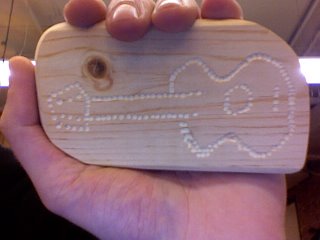Final Project Development
It is called SMS - the Secret Message Sweatshirt. (props to Amber Reed for the name)
What it is:
A system for personal expression, embedded in an everyday hooded sweatshirt. The system uses thermochromic ink, fabric swatches, conductive thread, conductive Velcro, conductive fabric tape, wrapping wire, and rechargeable lithium-ion batteries.
It is designed to be wearable, modular, durable, Eco-conscious, low-Tech, easy to use, easy to adapt, and most of all, fun.
A break down of the elements as I see them currently:

So, to explain in brief: The battery (encased in a secure but removable pouch in the pocket) is connected to a button switch, that, when activated, will send current to the conductive thread patches, which will heat up, and thus change the color of the ink on the patch, revealing a message/symbol/etc.
The ink changes color from black to clear, so the message underneath will have to be painted on the fabric beforehand (as the fabric color itself is black as well).
The complicated part of the process is getting the right amount of current to the patch, in an effective way. Too much current, and the patch will get too hot and possibly spark or short circuit; too little, and the ink won't change color at all.
The trick is resistance. The conductive thread heats up more effectively with greater resistance; different types of conductive thread have different resistances, so I have tested a number of different types:

Initially, I thought that sewing a circuit path from the battery to the patches with conductive thread would be feasible, but after experimentation, I realized a few things:
1. The entire length of the circuit would get hot, becoming very uncomfortable or even dangerous to the wearer.
2. By expending heat along the entire length of the circuit, I was reducing the effectiveness of the circuit by the time the current reached the patch.
3. By using wrapping wire to connect the battery to the patch, not only would I create a more stable connection, but I would reduce the heat loss, and potentially create a faster reaction time in the patch.
So, I switched to wrapping wire, as it has a few properties I thought were desirable:
1. It is insulated, allowing for effective current transfer without heating up.
2. It is thin enough to be stitched, or fastened in a way that would not reduce the comfort or wearability of the garment.
3. Less expensive, more reliable.
Now, the only thing left is to put it all together.
I have the hand-stitched battery holder with velcro:
 The wrapping wire:
The wrapping wire: The materials : conductive fabric tape, conductive thread, conductive and regular velcro, and fabric patches (not pictured: thermochromic ink, textile ink, sweatshirt)
The materials : conductive fabric tape, conductive thread, conductive and regular velcro, and fabric patches (not pictured: thermochromic ink, textile ink, sweatshirt) Now to put it all together in the grand finale!
Now to put it all together in the grand finale!Tune in soon to see how it all turns out.













